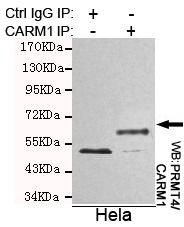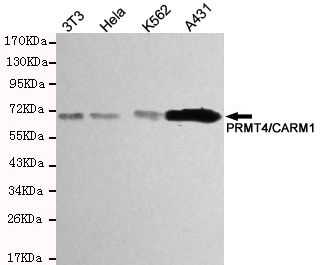-
Product Name
Anti-CARM1 (2B9) Mouse antibody
- Documents
-
Description
CARM1 (2B9) Mouse monoclonal antibody
-
Tested applications
WB, IP
-
Species reactivity
Human, Mouse
-
Alternative names
carm1;CARM1_HUMAN;Coactivator associated arginine methyltransferase 1;Coactivator-associated arginine methyltransferase 1;Histone arginine methyltransferase CARM 1; Histone arginine methyltransferase CARM1;Histone-arginine methyltransferase CARM1;PRMT 4;P antibody
-
Isotype
Mouse IgG1
-
Preparation
Antigen: Purified recombinant human PRMT4/CARM1 protein fragments expressed in E.coli.
-
Clonality
Monoclonal
-
Formulation
Purified mouse monoclonal in buffer containing 0.1M Tris-Glycine(pH 7.4 150 mM NaCl)with 0.02% sodium azide 0.1mg/mlBSA and 50% glycerol.
-
Storage instructions
Store at 4°C short term. Store at -20°C long term. Avoid freeze / thaw cycle.
-
Applications
WB: 1/200-1/500
-
Validations

Immunoprecipitation analysis of Hela cell lysates using PRMT4/CARM1 mouse mAb.

Western blot detection of PRMT4/CARM1 in Hela,A431 and K562 cell lysates using PRMT4/CARM1 mouse mAb (1:200-1:500 diluted).Predicted band size:63KDa.Observed band size:63KDa.
-
Background
Swiss-Prot Acc.Q86X55.This gene belongs to the protein arginine methyltransferase (PRMT) family. The encoded enzyme catalyzes the methylation of guanidino nitrogens of arginyl residues of proteins. The enzyme acts specifically on histones and other chromatin-associated proteins and is involved in regulation of gene expression. The enzyme may act in association with other proteins or within multi-protein complexes and may play a role in cell type-specific functions and cell lineage specification. A related pseudogene is located on chromosome 9.
Related Products / Services
Please note: All products are "FOR RESEARCH USE ONLY AND ARE NOT INTENDED FOR DIAGNOSTIC OR THERAPEUTIC USE"
